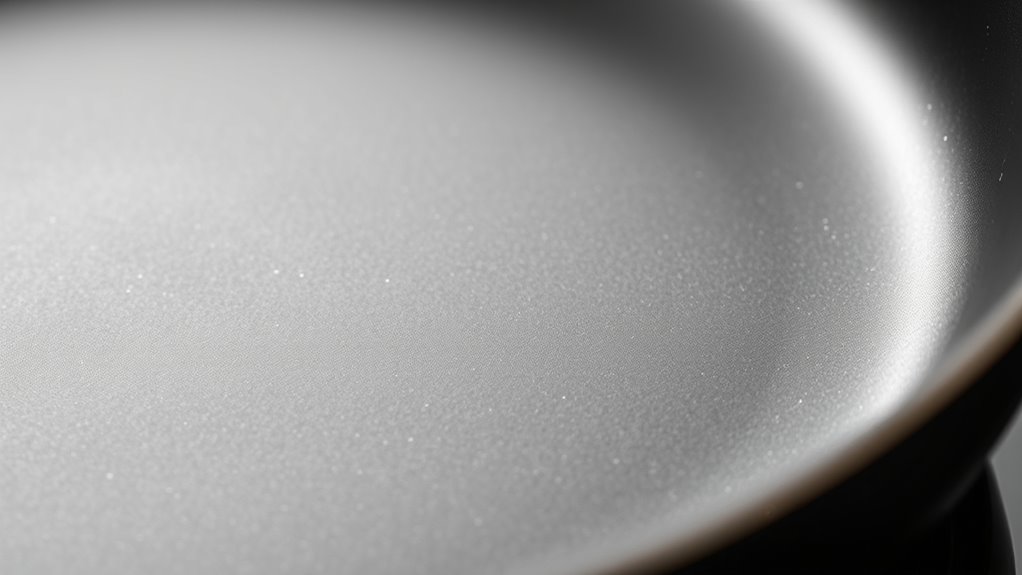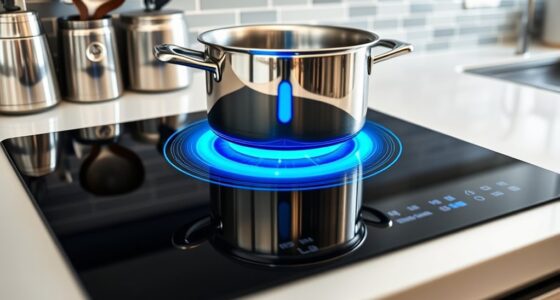Nonstick coatings mainly consist of PTFE, a durable, inert polymer formed through high-heat polymerization that creates a low-friction surface. While it resists high temperatures, overheating above 500°F can release toxic fumes containing fluoropolymers, risking health and safety. Many cookware still contain PFAS chemicals like PFOA, which are persistent pollutants with health concerns. To protect yourself and the environment, it’s important to understand these chemicals and explore safer, eco-friendly alternatives—more details await if you continue exploring.
Key Takeaways
- Nonstick coatings are primarily made from PTFE, a chemically inert polymer with fluorine atoms creating a low-friction, non-reactive surface.
- PTFE is applied and cured at high temperatures; overheating above 500°F releases toxic fumes containing fluoropolymers.
- PFAS chemicals, including PFOA, are added for durability but are persistent “forever chemicals” linked to health and environmental hazards.
- Many nonstick surfaces contain residual fluoropolymers or PFAS, raising concerns about chemical leaching and long-term safety.
- Eco-friendly alternatives include ceramic, enameled, and seasoned metal cookware, which avoid harmful chemicals and are more sustainable.
How Nonstick Coatings Are Made and Their Chemical Composition
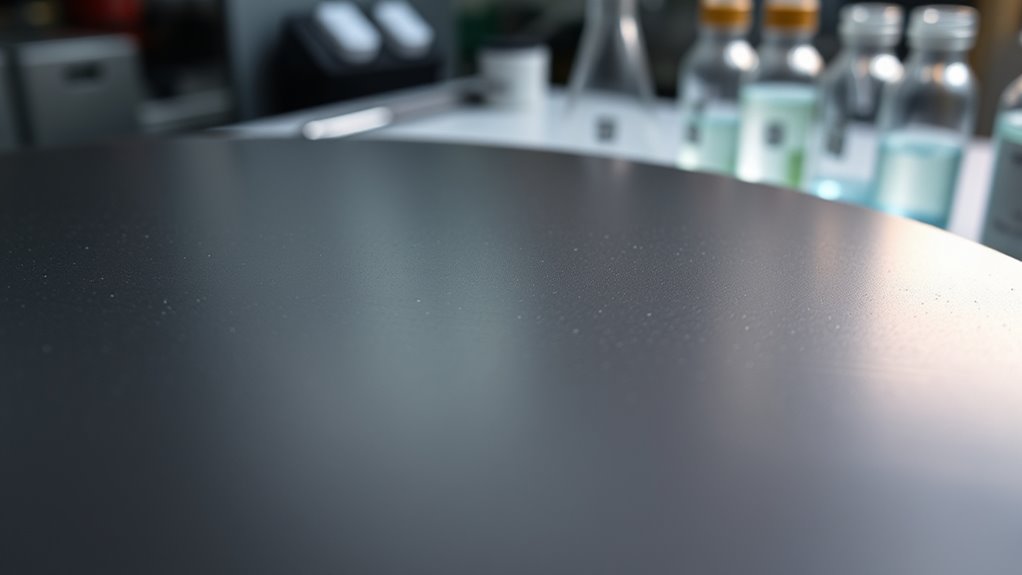
Nonstick coatings are primarily made from a special type of fluoropolymer called PTFE, or polytetrafluoroethylene. This material forms through a process called polymerization, where tetrafluoroethylene (TFE) monomers are linked together to create long chains. The fluoropolymer’s molecular structure consists of carbon chains surrounded by fluorine atoms, which give PTFE its unique properties. The fluorine atoms create a protective outer shell, making the molecule chemically inert and resistant to reactions. This chemical composition results in nonstick coatings with a low coefficient of friction, preventing food from sticking. During manufacturing, PTFE is applied as a coating on cookware and cured at high temperatures. Its molecular stability allows it to withstand high heat and chemical exposure, making it ideal for nonstick applications. Additionally, the high contrast ratio of the coatings helps in maintaining their non-reactive surface without degradation over time. The molecular stability of PTFE also contributes to its durability and long-lasting performance in various kitchen environments. Moreover, the chemical inertness of PTFE prevents it from reacting with most substances, ensuring safety and longevity in cookware. This inertness is further supported by its permanent chemical structure, which resists breakdown under typical cooking conditions. The inherent resistance to thermal degradation enhances its suitability for high-temperature cooking tasks.
The Role of PFAS and Other Chemicals in Nonstick Surfaces
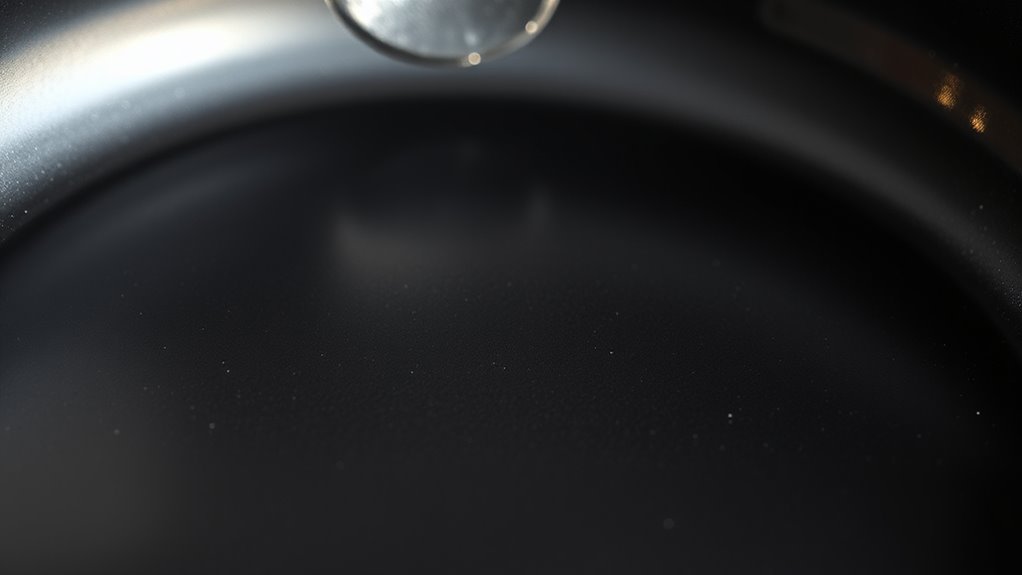
Have you ever wondered what chemicals give nonstick surfaces their remarkable slipperiness and durability? Many nonstick coatings rely on PFAS chemicals, including PFOA and other PFAS compounds, to enhance performance. These chemicals form part of the fluoropolymer family, like PTFE, creating a chemical structure that’s highly resistant to sticking and heat. Despite being labeled “PFOA-free,” many nonstick surfaces still contain other PFAS chemicals, which are often called “forever chemicals” because they resist breakdown and accumulate in bodies and the environment. The chemical composition of these substances makes nonstick cookware slippery and durable but also raises health risks associated with exposure, such as hormone disruption and cancer. Understanding the role of PFAS helps you better grasp what’s behind the nonstick coating’s impressive properties. Additionally, ongoing research highlights the importance of chemical safety protocols to minimize potential health impacts. Regulatory guidelines are evolving to address these concerns and promote safer manufacturing practices. Being informed about environmental persistence of PFAS can aid in making healthier choices regarding cookware. Moreover, public awareness about these chemicals is crucial for encouraging regulatory changes and safer consumer products. As consumer demand shifts toward safer alternatives, manufacturers are exploring eco-friendly coatings that do not rely on PFAS compounds.
The Safety Concerns Linked to PTFE and PFOA
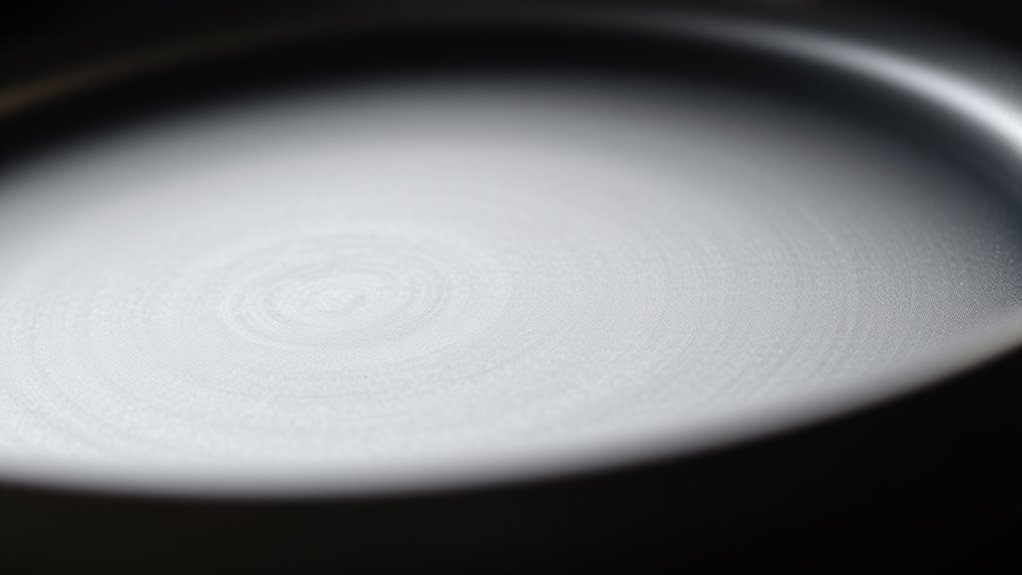
PTFE, the main chemical in Teflon, can release toxic fumes when heated above 500°F, posing serious inhalation risks. These fumes contain fluoropolymers that can cause polymer fume fever, with flu-like symptoms such as chills and respiratory distress. PFOA, once used in manufacturing PTFE, is linked to health risks like cancer, hormone disruption, and developmental issues, prompting its phase-out. Although many nonstick coatings are now labeled “PFOA-free,” residual fluoropolymers or related chemicals may still be present, raising concerns over chemical safety. Overheating cookware coated with PTFE can produce fumes that threaten your health, especially if the cookware chemicals are not properly managed. chemical safety can be improved by researching and opting for alternative cookware options that do not rely on potentially hazardous chemicals, promoting safer cooking practices. Additionally, understanding indoor air quality and ensuring adequate ventilation can help mitigate exposure to harmful fumes during cooking. Proper ventilation systems and avoiding overheating cookware are recommended to reduce health risks associated with non-stick coatings. Furthermore, choosing cookware made from safer materials can significantly reduce chemical exposure during cooking.
How Heat Affects Nonstick Coatings and Releases Toxins
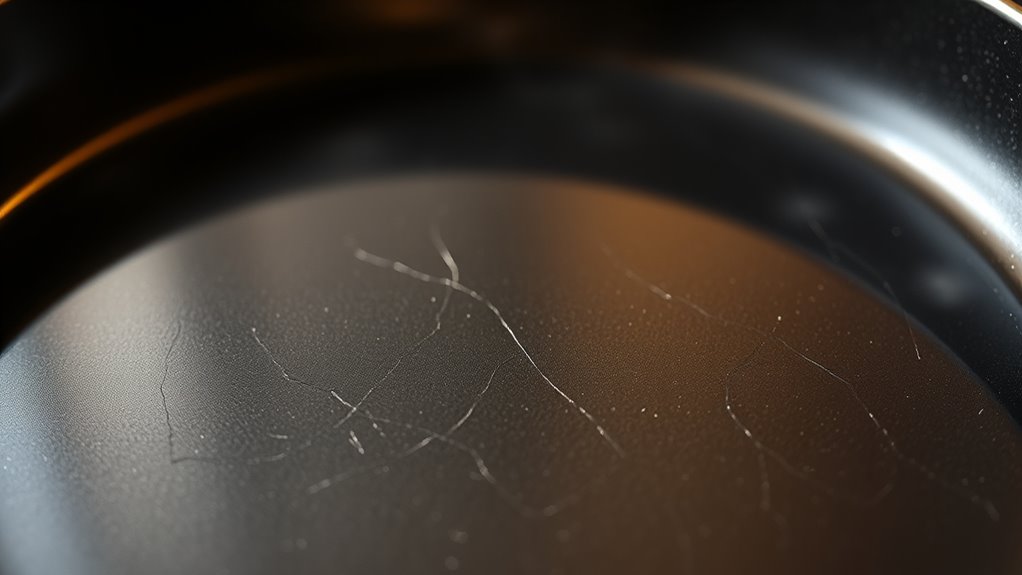
When cookware heats above 500°F, the nonstick coating begins to break down and release toxic fumes. At around 600°F, significant emissions occur, risking your health. Overheating causes PTFE to degrade, releasing harmful chemicals and fumes that can trigger polymer fume fever—flu-like symptoms. Damaged or scratched pans are especially prone to chemical release when exposed to high heat. Using vetted cookware and monitoring temperature can reduce these risks. Additionally, understanding headphone safety and proper usage can help prevent damage that might lead to more serious issues. Being aware of chemical safety practices can further minimize exposure to harmful fumes during cooking.
Environmental Impact of Nonstick Chemicals and Waste Disposal
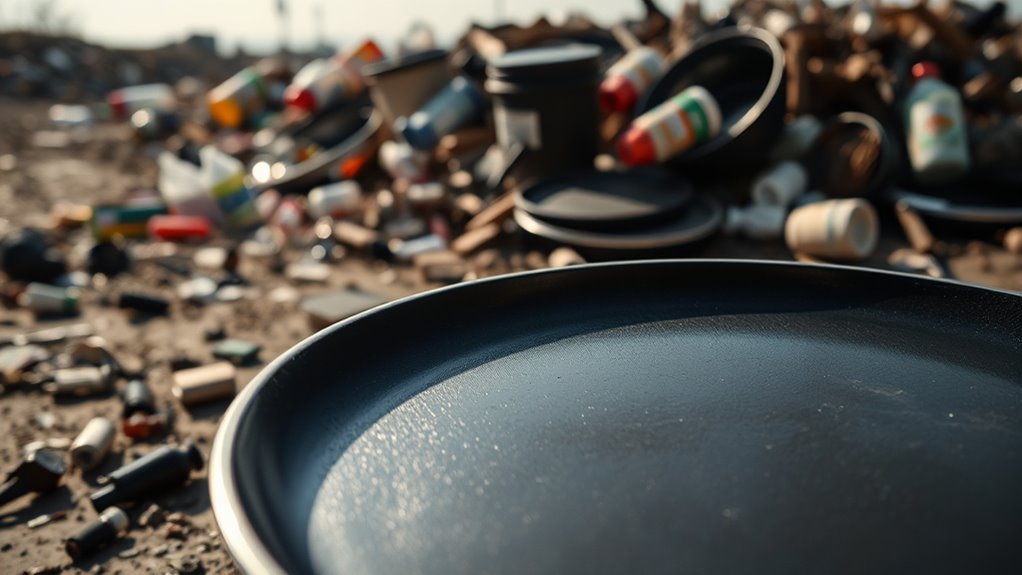
As nonstick coatings break down at high temperatures and release toxins, their environmental impact becomes a growing concern. When PFAS, PFOA, and PTFE-coated cookware reach landfills, they can persist for decades, causing environmental contamination. Disposal challenges arise because recycling is difficult; chemical residues and high temperatures cause PFAS to leach into soil and water. These persistent chemicals, often called “forever chemicals,” contaminate groundwater and soil, threatening wildlife and human water supplies. Studies show at least 45% of U.S. tap water contains PFAS from discarded cookware. The environmental impact worsens during manufacturing and waste disposal, contributing to global PFAS pollution and risking ecosystems. Nonstick cookware waste isn’t just trash—it’s a long-lasting pollutant with serious consequences. Additionally, the environmental persistence of these chemicals means they can accumulate in ecosystems over time, leading to long-term ecological harm. Furthermore, the difficulty in recycling nonstick waste exacerbates the problem, as most materials cannot be processed safely without risking further contamination. The hazards associated with disposal of these chemicals emphasize the need for more sustainable alternatives and responsible waste management practices. Recognizing these issues, researchers are exploring safer, biodegradable coatings to reduce chemical hazards and environmental impact.
Choosing Safer Alternatives and Better Cookware Options
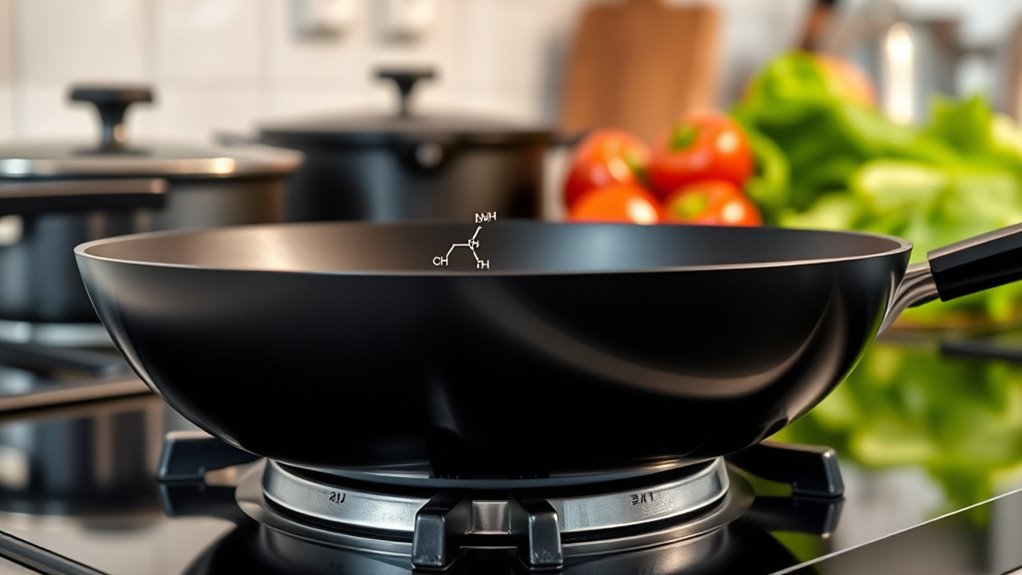
When selecting cookware, you have safer options like stainless steel, cast iron, or anodized aluminum that don’t contain harmful chemicals like PFAS or PFOA. Ceramic nonstick surfaces with Sol-gel technology provide a chemical-free choice but may need replacing more often. Choosing durable, non-toxic cookware and avoiding damaged pans helps protect your health and the environment.
Metal Cookware Advantages
Metal cookware offers a safe and durable alternative to coated nonstick pans, especially since traditional metals like stainless steel, cast iron, and carbon steel are free from potentially harmful chemicals like PFAS and PFOA. These options are non-toxic, highly durable, and built for high heat resistance. With seasoned cast iron and carbon steel pans, you develop a natural nonstick surface that lasts a lifetime with minimal effort. Enameled cast iron provides a non-reactive, high heat-resistant surface without seasoning, reducing chemical leaching. Plus, metal cookware is recyclable and environmentally sustainable, supporting eco-friendly choices.
- Feel confident with chemical-free cooking.
- Enjoy long-lasting durability.
- Benefit from high heat resistance.
- Make an environmentally responsible choice.
Safe Nonstick Choices
For safer nonstick cooking, consider ceramic-coated cookware or seasoned cast iron, both free from harmful chemicals like PFAS, PFOA, and PTFE. Ceramic nonstick offers a non-toxic, eco-friendly alternative to traditional nonstick coatings, providing a safer nonstick experience. Reputable brands like Greenpan and Xtrema disclose their materials, ensuring no toxic chemicals are used. These nonstick cookware options are durable, but keep in mind that ceramic nonstick pans typically last 1-2 years and perform best at low to medium heat. Traditional metals like stainless steel, carbon steel, and enameled cast iron are also excellent, naturally nonstick, and free from harmful chemicals. To maintain safety, avoid scratched or overheated nonstick cookware and choose products with transparent, eco-friendly manufacturing practices.
Environmental Impact Considerations
Choosing cookware free from harmful chemicals like PFAS, PFOA, and PTFE not only reduces your health risks but also lessens environmental contamination. When you select safer options, you help prevent pollution and protect ecosystems from toxic chemicals that leach from nonstick coatings. Consider these impactful choices:
- Opt for eco-friendly cookware made from durable materials like stainless steel or ceramic.
- Avoid nonstick pans containing PFAS, PFOA, or PTFE to reduce chemical safety concerns.
- Support regulations banning harmful chemicals, encouraging manufacturers to produce sustainable options.
- Reduce waste and pollution by choosing long-lasting, non-toxic cookware that minimizes chemical release during use and disposal.
Frequently Asked Questions
What Is the Chemistry of Non Stick Pans?
You want to understand the chemistry of nonstick pans. These pans typically use PTFE, a fluoropolymer with a carbon backbone and fluorine atoms. The fluorine creates a slippery, inert surface that prevents food from sticking. When heated above 600°F, PTFE breaks down and releases toxic fumes. Variations like ceramic coatings use different chemicals but aim for similar nonstick and low-friction properties.
What Is the Composition of Non-Stick Coating?
Imagine trying to stick a magnet to a fridge—non-stick coatings work the same way. You’re asking about their composition, which mainly involves fluoropolymers like PTFE. These are large molecules with carbon chains wrapped in fluorine atoms, creating a protective, inert shell. This structure makes the surface slippery and resistant to food adhesion, allowing you to cook with less oil and easier cleanup.
What Makes a Good Non-Stick Coating?
A good non-stick coating prevents food from sticking by having a low coefficient of friction. You want it to be chemically stable and resistant to high temperatures, up to 500°F, to avoid fumes and degradation. Durability matters, so choose a scratch-resistant surface that withstands repeated use without peeling. Inert materials like PTFE, ceramic, or PEEK are ideal, ensuring safety and minimal chemical reactions with your food.
Why Was Teflon Discontinued?
You wonder why Teflon was discontinued, and it’s because of health concerns tied to PFOA, a chemical used in its production. Research linked PFOA to cancer and developmental issues, prompting regulators and companies to phase it out. Even though new Teflon products no longer contain PFOA, older cookware might still have residual chemicals. This shift led to safer, PFOA-free nonstick options becoming available for your safety.
Conclusion
Understanding the chemistry behind nonstick coatings helps you make wiser choices in your kitchen. While these surfaces offer convenience, being mindful of their chemical composition and how heat affects them can guide you toward safer options. By exploring greener cookware, you’re gently steering away from potential concerns, creating a more harmonious cooking environment. Small changes can lead to a healthier, more sustainable routine—your kitchen can become a peaceful oasis of safety and care.
